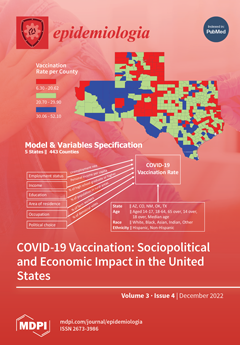A study was conducted to determine the seroprevalence and risks factors of
Coxiella burnetii in zebu cattle from the northern regions of Cameroon. From a total of 2016 (1754 females and 262 males) sera sampled, 801, 762 and 453 were collected, respectively, from
[...] Read more.
A study was conducted to determine the seroprevalence and risks factors of
Coxiella burnetii in zebu cattle from the northern regions of Cameroon. From a total of 2016 (1754 females and 262 males) sera sampled, 801, 762 and 453 were collected, respectively, from Adamawa, North and Far North, and screened for
Coxiella burnetii using indirect enzyme-linked immunosorbent assay (iELISA). A total of 23.76% (479/2016) were serologically positive. The seroprevalence of Adamawa, North and Far North were 29.09% (233/801), 19.95% (152/762) and 20.75% (94/453); respectively. The seropositivity of male and female were 4.58% and 26.62%; respectively. Cattle from Adamawa region were more likely to have been exposed to
C. burnetii than animals from Far North region (OR = 3.28; 95%CI: 1.13–7.85;
p = 0.02). The Gudali breed was significantly more infected than Aku (OR =2.52; 95%CI: 1.06–5.99;
p = 0.03), and animals aged of (6–9) years were 1.89 times more likely to have been infected to
C. burnetii than young animals (
p = 0.03). The seropositivity to this bacterium was significantly associated to pregnant cattle than non-pregnant (OR = 1.71; 95%CI: 1.01–2.90;
p = 0.04). Female cattle were more likely to have been infected by
C. burnetii than male and the rainy season were 1.66 more associated to this disease than dry season. The linear regression model indicated that
C. burnetii seropositivity were positively correlated to the regions (0.09, CI: 0.04; 0.18;
p = 0.007), age (0.01, CI: −0.01; 0.04;
p = 0.02), sex (0.19, CI: 0.08–0.32,
p = 0.001) and physiological status (0.11, CI: −0.04; 0.26;
p = 0.006). This study revealed that
C. burnetii infection is widespread among zebu cattle of Adamawa, North and Far North of Cameroon.
Full article





